This question is really difficult to ask, but I know you guys here at Stack Overflow are the brightest minds.
I'm totally blinded by why this issue happens (I'm fairly at Python and Pygame, so any suggestions on how to improve the code will be received with the love of improving my skills).
What I'm creating: It's really a gimmick project, I have a little 2.5" screen (PiTFT) attached to a Raspberry Pi and the code is creating a typewriter effect with a moving cursor in front of the text as it's being written.
Challenge 1 was that every time you move a sprite in pygame, you must redraw everything, otherwise you will see a trail, and since the cursor is moving in front of the text, the result would look like this:
I managed to solve this issue by blackening / clearing the screen. But then I lost all the previously written letters. So I created a list (entireword), which I'm populing with all the previously written characters. I use this list every time I cycle through the loop to redraw all the previous written text. So now:
As you can see, the text looks funny. It's supposed to read:
[i] Initializing ...
[i] Entering ghost mode ... []
I've been spending hours and hours getting to this point - and the code ALMOST works perfectly! The magic happens in the function print_screen(), but WHAT in my code is causing the text to include a letter from the other line in the end? :>
Help is GREATLY appreciated <3
Here's the entire code:
import pygame
import time
import os
import sys
from time import sleep
from pygame.locals import *
positionx = 10
positiony = 10
entireword = []
entireword_pos = 10
counter = 0
entire_newline = False
#Sets the width and height of the screen
WIDTH = 320
HEIGHT = 240
speed = 0.05
#Importing the external screen
os.putenv('SDL_FBDEV', '/dev/fb1')
os.putenv('SDL_MOUSEDRV', 'TSLIB')
os.putenv('SDL_MOUSEDEV', '/dev/input/touchscreen')
#Initializes the screen - Careful: all pygame commands must come after the init
pygame.init()
#Sets mouse cursor visibility
pygame.mouse.set_visible(False)
#Sets the screen note: must be after pygame.init()
screen = pygame.display.set_mode((WIDTH, HEIGHT))
# initialize font; must be called after 'pygame.init()' to avoid 'Font not Initialized' error
myfont = pygame.font.SysFont("monospace", 18)
#Class
class cursors(pygame.sprite.Sprite):
def __init__(self):
pygame.sprite.Sprite.__init__(self)
self.image = pygame.Surface((10, 20))
self.image.fill((0,255,0))
self.rect = self.image.get_rect()
self.rect.center = (positionx + 10, positiony + 10)
def update(self):
self.rect.x = positionx + 10
self.rect.y = positiony
#Functions
#Prints to the screen
def print_screen(words, speed):
rel_speed = speed
for char in words:
#speed of writing
if char == ".":
sleep(0.3)
else:
sleep(rel_speed)
#re-renders previous written letters
global entireword
# Old Typewriter functionality - Changes position of cursor and text a newline
#Makes sure the previous letters are rendered and not lost
#xx is a delimter so the program can see when to make a newline and ofcourse ignore writing the delimiter
entireword.append(char)
if counter > 0:
loopcount = 1
linecount = 0 # This is to which line we are on
for prev in entireword:
if prev == 'xx':
global linecount
global positiony
global loopcount
linecount = linecount + 1
positiony = 17 * linecount
loopcount = 1
if prev != 'xx': #ignore writing the delimiter
pchar = myfont.render(prev, 1, (255,255,0))
screen.blit(pchar, (loopcount * 10, positiony))
loopcount = loopcount + 1
if char != 'xx':
# render text
letter = myfont.render(char, 1, (255,255,0))
#blits the latest letter to the screen
screen.blit(letter, (positionx, positiony))
# Appends xx as a delimiter to indicate a new line
if entire_newline == True:
entireword.append('xx')
global entire_newline
entire_newline = False
global positionx
positionx = positionx + 10
all_sprites.update()
all_sprites.draw(screen)
pygame.display.flip()
screen.fill((0,0,0)) # blackens / clears the screen
global counter
counter = counter + 1
#Positions cursor at new line
def newline():
global positionx
global positiony
positionx = 10
positiony = positiony + 17
all_sprites = pygame.sprite.Group()
cursor = cursors()
all_sprites.add(cursor)
#Main loop
running = True
while running:
global speed
global entire_newline
words = "[i] Initializing ..."
entire_newline = True
newline()
print_screen(words,speed)
words = "[i] Entering ghost mode ..."
entire_newline = True
newline()
print_screen(words,speed)
#Stops the endless loop if False
running = False
sleep(10)



 repl.it/@Rabbid76/PyGame-Typewriter
repl.it/@Rabbid76/PyGame-Typewriter